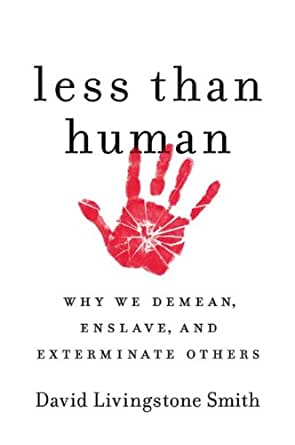Categorizing people by race, then ranking races, leads to dehumanization.
David Livingston Smith has a new book, On Inhumanity: Dehumanization and How to Resist It, which offers a helpful review of the kinds of psychological and social structures that lead to dehumanization and mistreatment of others.
Smith defines dehumanization as conceiving of another person as subhuman. He asserts that:
“Given the right circumstances, virtually all of us are capable of slipping into the dehumanizing mindset, and committing acts of cruelty that would otherwise be difficult or even impossible for us to perform. (p. 6)
As I’ve pointed out too, individuals can shift into survival systems—fear, rage, or panic states which are intertwined with the stress response—that shift the body toward self-protection (Narvaez, 2014). If my babyhood has been severe or if I was traumatized later, my brain can be “wired” to downshift to survivalism more easily and automatically than for those who have resilient brains, whose brains are wired for staying connected to others and self-calming when threat is perceived. (Evolved nest experience supports optimal normal development.)
Such brain shifting occurs through “neuroception”—the automatic preconscious assessment of safety or threat in every situation (Porges, 2011). Neuroception can occur bottom-up through sensory triggers in the environment that operate automatically to put us into a safety vs danger mindset. Neuroception can also occur top-down from concepts that we’ve learned from others. For example, if we are repeatedly told that ‘green people are dangerous,’ when we are faced with one, we will shift into a self-protectionist mindset (Narvaez, 2014). In other words, our cultural and social systems can set up learned interpretations about the world, not ones based on our own experience, but on what we’ve been told.
But it’s not only the individual person’s psychological traits or states of mind that lead to dehumanization. The sociopolitical structures also play a role. “Dehumanization is a psychological response to political forces” (Smith, p. 101). Inhumanity has been a characteristic of most hierarchical civilized societies in the historical period (the last 1% of human genus existence).
The Role of Racism
Smith gives a definition of racism as “the belief that races exist and that some races are intrinsically superior to others.” You don’t need to be hostile to be a racist, but you do need to rank groups. If you think members of a particular group are inferior, to have less intrinsic value than those of another group, you are exhibiting racism. Such racialized categorizations and rankings emphasize a hierarchy of value among peoples.
This grouping of people by “race” has a long history. The ancient Greek philosopher, Aristotle, discussed two kinds of people: Greeks and everyone else. Aristotle lumped together all non-Greeks as Barbarians —rather than, for example, as Syrians, Ethiopians, or Persians. Barbarians were assumed to be less rational than Greeks. Barbarians were ‘slaves by nature,’ meaning that it was natural for Greeks to enslave them. Similar ideas were used to justify colonialism and enslavement of peoples around the world by European powers.
During the Atlantic slave trade, Europeans and Americans lumped together African peoples as Blacks (Negroes, historically), dismissing the fact they came from different societies.
It should be noted that ranking perceived races in these ways is not scientific: the distinct racial types many people think of do not exist at the biological level (Roberts, 2012; Rosenberg et al., 2002; Saini, 2019).
Smith describes several historical events that demonstrate the shift into the dehumanizing mindset. The most famous, of course, is Nazi Germany.
For the Nazis, depravity was perceived to be built into people of Jewish heritage —not even one member of the group was redeemable.
“The Holocaust teaches us that when we are in the grip of a dehumanizing mindset, we often see the dehumanized other as toxic and frightening, resulting in what perpetrators see as a life-and-death struggle against a deadly enemy” (Smith, 2020, p. 28).
It’s important to remember that the dehumanizers actually believe that the people they persecute are less than human, making the process of dehumanization very dangerous.
Similar attitudes were evident towards natives of the Americas (“The Indian always returns to his blanket”—meaning they could not be “civilized”) and toward Black slaves who were assumed to have savage urges (Smith, 2020, p. 49). Lynching shows the worst of dehumanization behavior—sadism, torture, along with murder. Black slaves who wanted to escape slavery, their presumed natural state, were even thought to have a psychiatric disorder—”drapetomania”—and were whipped as a remedy.
Smith contends that “as long as racism persists, dehumanization is just around the corner” (pp. 43-44). Racism projects some as lesser human beings whereas dehumanization projects a less-than-human nature. “Dehumanization is racism on steroids” (p. 52).
A Deeper Problem: De-Personification
From the perspective of First Nation peoples and those who have lived sustainably for thousands of years, Smith may not go far enough (Narvaez, Four Arrows, Halton, Collier and Enderle, 2019). In most societies for most of human existence, the world was “personified”—full of persons, some of whom are human, and families of persons (whether bear, beaver, deer, raven, or whale) (Martin, 1992, 1999). In the view of deep ecologists (e.g., Arne Naess; Drengson and Devall, 2008) Smith may be taking too narrow a scope, not going to the root of the problem: the de-animation of the earth, perceiving other beings as less than sentient, and establishing humans as the only important living beings (Harvey, 2017). A value hierarchy among living things, taken up by civilization, may have started the ball rolling toward all the “isms” (racism, sexism, etc.), as Bram (2018) notes on multiple levels, leading to the human version of dehumanization.
Bottom line: We can convince ourselves to believe others are subhuman or not persons, through cultural narratives or through a threat-sensitive neurobiology, or a combination. To believe another is not a real person empowers us to commit acts of cruelty and destruction.


